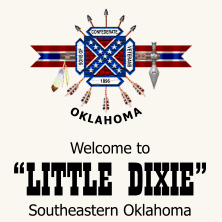A Brief History of Captain James J. McAlester
McAlester, Oklahoma
(The Heart of Little Dixie)
Special Thanks to okstate.edu & Oklahoma Historical Society
James Jackson McAlester, also known as "J. J." McAlester, contributed to the development of the Choctaw Nation in Indian Territory and later emerged as a prominent and influential leader in the state of Oklahoma. He has been hailed as "the Father of Eastern Oklahoma," and contemporaries acclaimed him as the founder of the Oklahoma coal industry and the southeastern Oklahoma town of McAlester. McAlester served as one of Oklahoma's most respected businessmen and politicians.
Born in Sebastian County, Arkansas, on October 1, 1842, McAlester spent his formative years in Ft. Smith, Arkansas. Volunteering for service in the Confederate Army at the outbreak of the War Between the States, he rose to the rank of captain prior to discharge. At the conclusion of War McAlester boarded with Oliver Weldon while pursuing studies in Fort Smith. Weldon, a former engineer who had surveyed Indian Territory, gave McAlester his memorandum book that detailed vast coal fields at the Cross-Roads area in Indian Territory. With this valuable information, McAlester left school and moved to the Indian Territory. At age 24, he entered the Choctaw Nation and found employment with the Indian trading firm of Harlan and Rooks. Later he worked for Reynolds & Hannaford, a firm of post traders. Eventually McAlester bought out his partners and established a store near the outcroppings of coal.
In 1872 McAlester courted and married Rebecca Burney, a Chickasaw girl and sister of Ben Burney, a future governor of the Chickasaw Nation. This union brought McAlester full citizenship and rights in both Choctaw and Chickasaw nations. His citizenship entitled him to stake a claim to coal deposits within a one-mile radius from point of discovery. Over time, McAlester's interests in coal burgeoned, and with the arrival of the Missouri, Kansas and Texas Railway through the Cross-Roads area, the J. J. McAlester Mercantile Company flourished as coal production soared.
During McAlester's colorful lifetime he worked in politics, mining, banking, business, law enforcement, and ranching. In 1893 President Grover Cleveland appointed him the U.S. marshal for Indian Territory. He served one term ending in 1897. From 1907 to 1911 he acted as a member of the Oklahoma Corporation Commission. In 1911 the people of Oklahoma elected him lieutenant governor under Governor Lee Cruce. On September 21, 1920, J. J. McAlester died in the town that bears his name.
What is "Little Dixie"?
Here is a very brief explanation, and a history of, why Eastern Oklahoma is known as 'Little Dixie'.
Little Dixie is the name given to southeast Oklahoma, also known as Kiamichi Country, which is heavily influenced by southern "Dixie" culture, as it was settled chiefly by Southerners seeking a start in new lands following the War Between the States. The region is not clearly defined; its exact boundaries vary by source, falling mostly within the Choctaw Nation of Oklahoma's tribal area as well as some Chickasaw and Muscogee Creek lands. During the tenure of Carl Albert, it was considered to be the old 3rd Congressional district of Oklahoma. Today, it's the 2nd Congressional District. However, "Little Dixie" is mainly the East Central and Southern counties of the 2nd District, which basically would be the counties along Interstate 40 starting near Okemah, Oklahoma to Ft. Smith, Arkansas and then south toward the Red River.

The character of the region began to emerge in the mid-1830s with the arrival of the Choctaw and Chickasaw tribes in southeastern Oklahoma, then known as Indian Territory. Both had thoroughly appropriated Southern customs. The two tribes were the most resolute Confederate allies among the Five Civilized Tribes during the War Between the States. Throughout the nineteenth century, mainly Southerners, migrated legally and illegally into Oklahoma. By 1900, 87 percent of white settlers in the Indian Territory (eastern Oklahoma) were Southerners.
Geographers assert that distinctly southern qualities manifest more strongly in Little Dixie than in the remainder of the state. The predominant church affiliation has been Southern Baptist. Southern verbiage such as branch (for stream), snap beans, and toad frog are common among residents; and a passion for fried foods and Southern American Indian wild onion dinners speak of our Southern culture. Little Dixie also contains architectural elements typical of the Upland South, perhaps initially brought by the Five Civilized Tribes. Dog-trot log cabins, courthouse squares, and grave sheds in cemeteries all reflect Ozark or Appalachian hill country culture.
More than anything... the Southerners of this area are very proud of their heritage and will never be ashamed of it. For there is a rich, honorable history here with direct connections to the "Deep South". For those reasons... we will forever be... "Little Dixie"!



OUR CHARGE...OUR DUTY!
Lieutenant General Stephen Dill Lee
Commander-in-Chief
United Confederate Veterans Reunion - New Orleans, Louisiana
25 April 1906



